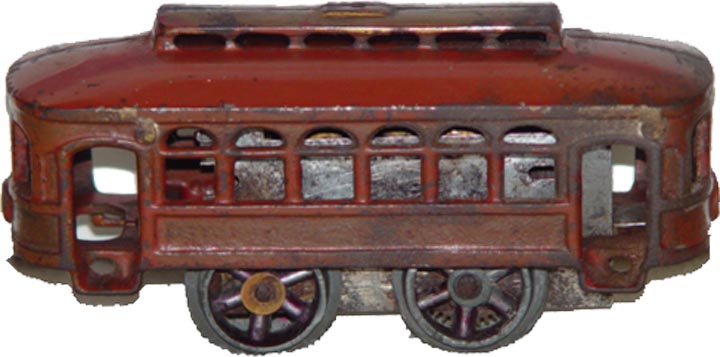Miss “Sophie” Trolley
By Jerry Loman
For those who seek the trolley there are endless varieties to choose from. Trolleys have crept into many collections of the main stream collectors but few train collectors seek out the trolley.
One of the first American manufactured track trolleys was made by American Flyer. Flyer introduced a realistic looking closed cabin trolley with a simple black and white sketch rendering of what they had to offer. It was added to the 1910 American Flyer catalogue. It was a small trolley having a body made of cast iron with six hole clerestory ventilators running across the top with trolley pole of wire. The sides consisted of door openings on each end with graceful steps leading into the trolley. Each end had a bow front prow with 3 windows and a small faux gold gilded head light centered below the windows. The 6 windows on the sides had an upper divider bar with elegant transoms to simulate the look of the times. The trolley as depicted had small cow catchers hung below each end. The illustration depicted a rather top heavy structure as the body appeared perched above the center line of the wheels axel.
My discussions with other collectors speculate that the trolley appeared top heavy. Recently, I acquired a similar trolley and went about trying to discern its’ origin. I say similar in that the trolley I found was entirely alike the catalogue depicted example except this one was missing the cow catchers. These cow catchers were not just missing or removed but manufactured without any. I carefully reviewed the casting and found that the cast methodology as evidenced by parting lines and paint indicated that this was manufactured this way.
The motor was the snap in motor similar to that made for Edmond Metzel Hardware by John Hafner the inventor. The wind up key passed through the casting, holding the motor in place in the casting. The motor had a large piece of lead wrapped on the bottom of the motor as received.
I removed the lead to clean the corrosion that was caused by the dissimilar metals of the steel motor and the lead. After giving the motor a good cleaning and lubrication, I attempted to run the trolley around the circle of track. With a little prodding I got it to take off but it quickly fell over on the curve. I temporarily re-attached the lead the original owner had placed on the trolley and was able to keep the trolley on the track. It appeared that the original owner found that the additional weight attached to the lower part of the motor lowered the center of gravity. Was this trolley without its’ cow catchers been an early attempt or prototype product offering that failed to successfully negotiate a radius when it got up to speed?
Would the addition of cow catchers on a later model have lowered the center of gravity enough to better negotiate the curves?
I made a number of calls to collectors and historians to confirm my suspicions. A consensus is that this trolley could very well be a prototype or early model not catalogued. Further my research found that the trolley was offered in the catalogue colored in yellow and green. My trolley was a Tuscan (red/brown) color. I obtained this trolley from an astute estate picker located in Niagara Falls, Ontario, Canada.
He had indicated that his daughter had been interested in the story of the toy trolley and I had promised to keep her posted on my findings. So Sophie from Niagara Falls, here you have it.
And to Bob Mintz, our famed editor of the Train Collectors Association “E train” magazine and author of the delightful series of articles named “Good Golly Missed Trolley”, here is a MISS TROLLEY. Miss Sophie.






